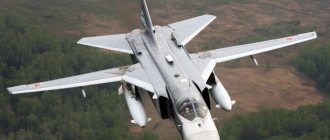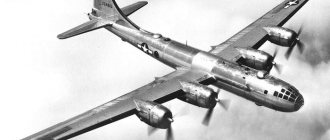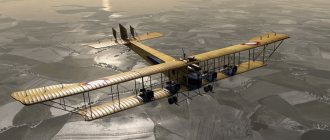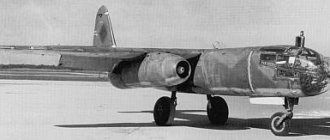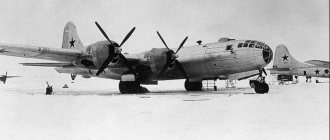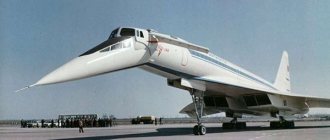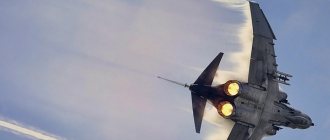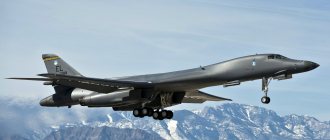The first production supersonic bomber Convair B-58A Hustler
The Convair B-58A Hustler (English: “pickpocket”) became the world’s first mass-produced supersonic long-range bomber. The vehicle was in service with the US Air Force in the 1960s. At the time of its creation, the bomber was not inferior to fighter aircraft in its maximum flight speed (M=2). Due to existing shortcomings, the operation of the machine was short-lived. A total of 116 aircraft of this type were produced in the United States, with 86 in the B-58A version. The Convair B-58 bomber had a great influence on the development of the American aviation industry. For the first time in practice in the United States, it was possible to test a systematic approach to managing an aircraft development program. In this case, Convair acted as the main contractor, which was responsible for leading the development and integration of all (except engines) components of the aircraft. In addition, a huge number of industrial enterprises and firms took part in the creation of the aircraft. At the beginning of 1961, their number reached 4,926 (in 44 states). The scale of the work is very large even by today's standards. The costs of the program were also record-breaking; taking into account the production of 116 bombers, they exceeded $3 billion. The American press of those years wrote that the Convair B-58A bomber was assembled from pure gold.
Description of design
The supersonic bomber was designed according to the “tailless” design and had a mid-mounted delta wing of low aspect ratio and high sweep. For its class, the aircraft was small in size: length - 29.5 meters, height - 8.9 meters, wingspan - 17.3 meters. Ensuring high flight speed forced the designers to develop a unique airframe design, almost the entire surface of which was made of three-layer glued aluminum structures. This made it very smooth and provided good streamlining. In places subject to increased heat, the cladding was made of steel panels, and the gluing was replaced by soldering. If necessary, all the skin from the aircraft could be removed. At the same time, the weight of the structure was only 16.5% of the take-off weight of the bomber.
The aircraft was equipped with 4 J79-GE-5 turbojet engines manufactured by General Electric, which developed a thrust of 5400 kgf at maximum mode, and 7070 kgf in afterburner mode. The fuel was located in 5 internal tanks, as well as in hanging containers (TCR type containers contained 14,705 liters, and MV-1 - 15,791 liters). To balance the bomber when passing the speed of sound or when dumping a container, fuel could be pumped into the tail balancing tank. At the same time, the aircraft was initially equipped with a “flying boom” type system for refueling in the air.
The airplane wing was a separate story. For its time, the wing of the Convair B-58A Hustler bomber had a very advanced aerodynamic design, including a conical twist. The latter not only solved balancing problems, but also made it possible to increase the flight range and somewhat reduce the inductive reactance. Since the internal volume of the wing was used to accommodate fuel reserves, aerodynamic heating of the wing skin during flights at supersonic speeds became a significant problem. If the fuel was heated, there could be its loss due to evaporation, as well as blockage of pipelines or disruptions in the operation of fuel transfer systems for balancing the machine.
Based on this, special recommendations for the operation of the bomber were prescribed. After taking off, the pilot had to quickly gain altitude before reaching the cold layers of the atmosphere, and a limitation was also imposed on the duration of the supersonic flight. At low and medium altitudes, the pilot had to sometimes slow down the plane to a speed of M = 0.9 in order to reduce the temperature of the wing. In order to avoid heating the fuel before departure, it was recommended to place the bomber in the shade, use special heat-insulating blankets, and even resort to cooling the fuel itself before refueling it into the bomber. In units for the “Hustlers”, special canopies were even built in the form of houses, which became one of the calling cards of the airfields where the B-58s were based.
The bomber's chassis was distinguished by unusually high struts, which made it possible to hang a huge container with weapons and fuel under the fuselage. The main eight-wheel landing gear was retracted into the wing, and the two-wheeled nose gear was retracted into the fuselage. At the same time, in order not to touch the hanging container, the front pillar was initially folded in half. The thickness of the wing was not enough for the main landing gear and it had to be increased in the area of the landing gear niches, forming a kind of wedge-shaped overhang on top.
B-58A bombers were almost always operated with an external sling under the fuselage. At the same time, the following could be suspended: 1) MC-1C - a guided missile with a liquid engine, which had an inertial guidance system. This missile could be equipped with either a nuclear warhead or a warhead with a charge of ordinary explosives. The missile launch range depended on the altitude of the aircraft at the moment the missile lifted off from the fuselage and ranged from 16 to 257 kilometers. In order to launch at maximum range, the pilot was forced to gain a high flight altitude, which turned the bomber into a very good target for modern enemy air defense systems. 2) MB-1C - a free-falling aircraft bomb or ballast to improve the flight characteristics of the aircraft. This container was used in the first years of operation of the bomber. 3) TCP is a special “two-component container”. One part of the hanging container contained the Mk53 bomb, the other - fuel reserves. There were two types of similar containers: BLU2/B1 and BLU2/B2, they differed from each other in size and weight. At the same time, it was possible to attach another MC-1 to the bomber - a container with reconnaissance equipment or 4 Mk43 megaton nuclear bombs.
To protect the rear hemisphere of the bomber, a six-barreled 20-mm M-61 automatic cannon, which had a remote control, was located in its tail section. At the same time, there were also means on board to counter electronically controlled weapons of a potential enemy. A separate crew member, the operator, was responsible for all defensive weapons and electronic warfare equipment. The defensive electronic warfare system of the B-58 bomber included: an AN/ALR 12 station with four antennas that provided all-round visibility. It was intended to warn of aircraft radar exposure. This station automatically controlled the release of dipole reflectors. Ten packages with them were located in the upper wing fairings of the niches of the main landing gear. Also on board was a reconnaissance and jamming station and anti-guided missile equipment with thermal target guidance systems.
The bomber's crew consisted of 3 people, who were located in a single sealed cabin one after another; the crew cabin was equipped with an air conditioning system. The pilot was in the first compartment, the navigator-bombardier was in the second, and the defensive weapons operator was in the third. The seats of all crew members were ejectable. Each of the three compartments was closed with its own opaque lantern. The compartments of the bombardier navigator and the defensive weapons operator had two small rectangular windows in the sides of the hull so that the crew members did not experience claustrophobia.
Car records
On January 12, 1961, Major G. Deutschendorf was able to set a flight record of 2000 km on a Convair B-58A Hustler bomber along a closed route with a short circle length, while achieving an average flight speed of 1708.8 km/h. Two days later, the plane under the control of Major G. Confer exceeded the flight record by 1000 km, reaching an average flight speed of 2067.57 km/h. And on May 10 of the same year, Major E. Murphy won the prize, which was established by Louis Bleriot in 1930. He became the first pilot to fly at a speed of over 2000 km/h for 30 minutes. Six days later, Major W. Payne and his crew successfully completed the flight from Carswell to Paris, setting a record flight time from Washington - 3 hours 39 minutes 49 seconds and from New York - 3 hours 19 minutes 51 seconds. And on October 16, 1963, the Hustler set a supersonic flight duration record of 5 hours, flying from Tokyo to London in 8 hours 35 minutes, while the aircraft required five mid-air refuelings.
Aircraft service
The first B-58A bombers began to enter service with US strategic aviation as a carrier of medium-range nuclear weapons even before the completion of the entire test program in August 1960. Pilots from the 43rd Bomb Wing were the first to begin mastering the new aircraft. While the aircraft was being fine-tuned, the headquarters were developing options for its combat use. Initially, it was planned to create three air wings, deploying them in the European theater of operations. The combat radius of these bombers allowed them to strike military targets and objects on the territory of the USSR right up to the Ural Mountains. The main task of the crews of the B-58A supersonic bombers was to destroy objects of the Soviet Union's air defense system; disabling it could open the way for heavy subsonic bombers B-52 and B-47.
At the same time, the very first year of operation of B-58 bombers in combat squadrons demonstrated that these aircraft are far from perfect. Pilots often complained about the difficulty of piloting the aircraft and the low reliability of some of its systems. The US Strategic Air Command, realizing that, apparently, it would not be possible to seriously improve the aircraft’s performance, in 1961 decided to limit itself to the deployment of two bomber wings: the 43rd and 305th. The last three aircraft were delivered to the US Air Force on October 26, 1962, and production of the aircraft was completed.
In total, from 1956 to 1962, 116 B-58A and TB-58A bombers were assembled, which were actively used until 1969. The pilots didn’t have much love for these planes. During testing and operation, 26 bombers were lost (22.4% of all vehicles produced) - this is a very high loss rate for peacetime. One of the bombers crashed in 1961 during a demonstration flight at the famous Paris Air Show in Le Bourget. Despite the fact that the aircraft's systems and equipment were modernized throughout the aircraft's operational life, the B-58A Hustler quickly became obsolete and was eventually withdrawn from service by the US Air Force. Already on January 16, 1970, the last two B-58A supersonic bombers were put into storage.
Aircraft disadvantages
The B-58 bomber could not last long in the US Air Force and repeat the record of its “colleague” B-52. Already in 1970, the last Convair B-58A Hustler aircraft were withdrawn from the Air Force. The plane had a sufficient number of disadvantages. One of the main ones was the limited flight range. And this despite the fact that fuel accounted for approximately 60% of the bomber’s take-off weight. At subsonic flight speeds, without in-flight refueling, the aircraft could cover 7,550 km. This figure did not satisfy the technical requirements, according to which the range of action was to be 4260 km in the presence of a supersonic flight segment of 370 kilometers. Under normal operating conditions, without refueling, the B-58 could fly at supersonic speed no more than 560-800 km.
The aircraft had a very dense internal layout. For this reason, access to various units during ground handling was very difficult, and the technicians themselves nicknamed the B-58 a “nightmare” aircraft. For example, one of the fairly frequently replaced radar elements was removed only after being lifted using a winch from the cabin of the rescue capsule. After replacing the element, the capsule was returned to its place, but if the radar did not work after that, the entire procedure was repeated again. To replace damaged skin elements, the bomber had to be placed on a slipway, since almost all the panels of its fuselage were power-bearing, and the removal of any of these panels threatened to lose the structural strength.
While on the ground, with the internal fuel tanks fully filled with fuel, the bomber had acceptable alignment only with a suspended container; without it, the vehicle simply “squatted” on its tail. For this reason, before removing the suspended container from the aircraft, it was necessary to drain the fuel from the internal tanks and, conversely, the aircraft was not allowed to be fully refueled before the container was suspended. In its absence, in order to prevent the aircraft from tipping over onto its tail, a counterweight weighing 2.8 tons was attached to the front suspension attachment point or to a unit in the niche of the nose landing gear.
Due to the complexity of operation and piloting, the bomber was demanding on the qualifications of pilots and ground support personnel. These requirements were among the highest in the US Air Force. Combat pilots for this aircraft were selected only on the personal recommendation of the wing commander and must have had at least 1000 hours of flight time by that time. Of these, at least 500 hours they had to fly as a crew commander on operating multi-engine jet aircraft (B-47, B-52, KC-135). During retraining, each B-58 pilot was required to complete 30 hours of simulator training and accumulate 90 flight hours. Among other things, due to lack of space in the flight deck, the US Air Force had restrictions on the height and weight of pilots for the B-58.
One of the disadvantages of the Hustler was also a clearly unsatisfactory view forward and down from the pilot’s cabin, which was especially negative during takeoff and landing. Approximately ten seconds before touching the ground, the pilot completely lost sight of the runway center line and controlled the bomber only using instruments and using lateral references.
With such a set of shortcomings, a huge price and difficulties in operation, the B-58 bomber, devoid of serious reserves for further improvement and intended exclusively for delivering nuclear strikes from high altitudes at high subsonic or supersonic flight speeds, had no chance of remaining in service for a long time. At that moment, a trend had already begun to form for multi-mode, multi-purpose aircraft capable of flying at low altitudes.
Convair B-58A Hustler airplane at Pima air museum, Tucson, Arisona, photo from blog igor113.livejournal.com
Flight characteristics of the Convair B-58A Hustler: Overall dimensions: length - 29.5 m, height - 8.9 m, wingspan - 17.3 m, wing area - 143.31 m2. The empty weight of the aircraft is 25,201 kg. Maximum take-off weight - 80,240 kg. Power plant - 4 J79-GE-5A/B turbojet engines, thrust - 5400 kgf each, afterburner - 7070 kgf. Maximum flight speed - 2120 km/h Cruising speed - 980 km/h. Practical flight range is 7600 km. Service ceiling - 19,300 m. Crew - 3 people (pilot, navigator-bombardier, defensive weapons operator). Armament: six-barreled 20-mm M61 Vulcan cannon (1200 rounds), up to 8800 kg bomb load.
Sources of information: https://www.airwar.ru/enc/bomber/b58.html https://www.krasfun.ru/2014/07/strategicheskij-bombardirovshhik-b-58-hustler-ssha https://www .airbase.ru/hangar/usa/convair/b/58/index-t.htm https://worldweapon.ru/sam/b58.php
options
XB-58 Initial prototype, 2 built. YB-58A Pre-production flight test aircraft, 11 built. B-58A Three-seat supersonic medium-range strategic bomber, 86 built. TB-58A Trainer, 8 pre-production YB-58A
were modified for pilot conversion, with dual joysticks, a raised seat in the second cockpit behind the pilot, and a new, larger glass canopy to provide the instructor with forward visibility.
and student; aerial refueling equipment retained, but ASQ-42V bomber and navigation radar, electronic countermeasures and defense systems removed; The first TB-58A
flew on May 10, 1960 and was delivered on August 13. NB-58A A unique prototype, converted into a test vehicle for the new J93 engine, intended to equip the new B-70 Valkyrie supersonic strategic bomber and transported in a ventral gondola under the central part of the aircraft fuselage. RB-58A Reconnaissance version with ventral reconnaissance capsule, 17 built. B-58B Unbuilt version with new modernization improvements. The US Air Force is expected to purchase 185 aircraft of this new and improved version. The project was canceled due to budget problems. B-58S Unbuilt version. It had a new, longer design with increased internal fuel capacity and a new, more powerful and efficient 14,750 kg thrust J58 engine, which is the same engine used in the later Lockheed SR-71 supersonic aircraft. [2]
Solution
Correctly prepare the drug BI-58 for use according to the following scheme:
- Considering that time is limited, first pour water into the spray tank to ¾ of the volume. At the same stage, additional water-soluble components of the mixture (fungicides, insecticides) are introduced.
- Based on the dosage indicated in the instructions, the measured amount of the chemical is dissolved in 1 liter of water.
- The mother liquor is poured into the main volume, not forgetting to stir the mass of water all the time.
Processing begins immediately.
Related aircraft
Related developments
- English Electric Canberra
Similar aircraft
- Avro Canada CF-105 Arrow
- North American A-5 Vigilante
- Convair F-106 Delta Dart
- Republic F-105 Thunderchief
- FB-111
- B-1 Throw
- Boeing XB-59
- Dassault Mirage IV
- Avro Vulcan
- Handley Paige Victor
- TANK TSR-2
- Myasishchev M-4
- Myasishchev M-50
- Tupolev Tu-22
Notation sequences
- Number
sequence (internal Convair): - - 3 -
4
- 5 - 6 - → - Secuencia B-_
(Bombarderos del USAAC/USAAF/USAF, 1926-1962): ← B-55 - B-56 - B-57 - B-58 -
B-59
- B-60 - B-61 →
Storage conditions
The safety data sheet contains the following criteria for storing the drug:
- temperature limits - from minus 10 to plus 25 degrees;
- shelf life in warehouses is 24 months;
- the protective abilities of the drug are not guaranteed when heated or exposed to direct sunlight;
- the properties of the insectoacaricide are lost when the permissible storage period is exceeded.
The manufacturer warns that the drug should be stored:
- where accidental access by children and animals is excluded;
- within the specified temperature limits;
- in a ventilated area;
- in warehouses equipped with a grounding system.
Used containers are disposed of in accordance with hazardous waste requirements.
external reference
- Video and YouTube.
- (1959) TO 1B-58A-1 Flight Manual USAF B/RB-58A Aircraft (broken link available at Internet Archive; see history, first and last version). .
- "Champion of Champions (1962)" on YouTube..
- Page B-58 Hustler Association.
- Convair B-58 Hustler Rendezvous.
- B-58 profile at Aviation-history.com.
- Photos of a Lockheed Martin Aeronautics B-58, posted on the Texas History Portal.
- B-58 Voice Warning Messages. Archived November 16, 2022, at the Wayback Machine.
- Offensive Systems and Pod.
| authoritative control |
|
- Data: Q599891
- Multimedia: Convair B-58 Hustler
Analogs
The drug BI-58 is replaced with products containing the same active ingredient, dosage - 400 g/l. The table lists insecticides with similar characteristics, indicating the differences:
| Name | Hazard class (people/bees) | End of registration | Release form (canister, liter) |
| "Alpha Director" (imp.) | 2/1 | 2025 | 10 |
| "Binadin" (RF) | 3/1 | 2024 | 5,10 |
| "Bishka" (imp.) | 3/1 | 2024 | 5 |
| "Danadim Expert" (imp.) | 3/1 | 2021 | 5 |
| "DI-68" (imp., Russian Federation) | 3/1 | 2029 | 5 |
| "Dimetron" (imp.) | 2/1 | 2027 | 10 |
| "Dimephos" (imp.) | 2/1 | 2024 | 10 |
| "Rogor-S" (RF) | 3/1 | 2029 | 10 |
| "Sirocco" (RF) | 3/1 | 2022 | 5,10 |
| "Fostran" (imp.) | 3/1 | 08/30/2020 (2 years storage) | 10 |
Advantages and disadvantages
Summing up the description of the insectoacaricide, we note the advantages of the series:
- The range of pests destroyed by the drug is one of the widest.
- Rare FOS can be used to treat plantings repeatedly, and BI-58 allows this.
- Systemic effect on the target.
- High performance.
- Operates at temperatures from -5 °C to +30 °C.
- Simple preparation of the solution and working with it.
- Compatible product - can be mixed with many fungicides and insecticides.
- Neutralization in the ground for a maximum of 2 weeks.
- Relatively low cost - within 1100 rubles per liter.
The disadvantages include:
- High degree of danger during work and limited access without PPE.
- Prohibition on spraying indoor plantings, inadmissibility of use for indoor plants.
- Does not protect against the Colorado potato beetle or locust.
- Safe for pest eggs.
- Inability to store the prepared solution.
Methods of application for different crops
Agricultural enterprises use the insecticide “BI-58” to protect hectares of cereal or fruit and berry plantings. Therefore, the regulations indicate doses in liters (l/g):
| Culture | Norm (l) consumption per 1 ha | Time of processing |
| Cereals | 100-200 | 1 - according to germination, 2 - vegetation |
| Apple trees | 600-800 | 1 - before flowering, 2 - after |
| Plum | Up to 1200 | After flowering |
| Grape | 500-1000 | 1 - before flowering, 2 - after |
| Beet | 200-400 | Vegetation |
| Potato | 200-400 | Vegetation |
| Raspberries, gooseberries, currants | 600-1200 | Before flowering |
There is no information in the regulations for cabbage, tomatoes, cucumbers, garden strawberries, roses, and ornamental shrubs. But since in the gardens of private owners these crops more often than others require protection, summer residents use a drug that is not recommended for private household plots at their own peril and risk.
Characteristics
Drawing of 3 types of Convair B-58 Hustler.
General characteristics
- Crew:
three (pilot, co-pilot and system operator) - Longitude:
29.5 (96.8 ft) - Wingspan:
17.3 (56.8 ft) - Altura:
9.6 (31.4 ft) - Total area: 143.3
(1,542 ft²) - Airfoil: root NACA 0003.46-64.069
, tip NACA 0004.08-63 - Empty weight:
25,200 kg (55,540.8 lb) - Curb weight:
30,786 kg (67,852.3 lb) - Maximum takeoff weight:
73,936 kg (162,954.9 lb) - Powerplant:
4 × General Electric J79-GE-5A turbojet engines.
Normal thrust
: 69.3 thrust (7,067 kgf; 15,579 lbf) each.
Performance
- Never exceeded speed (Vne):
2,123 km/h (1,319 mph; 1,146 kn) (Mach 2.0) at 12,000 m - Cruise speed (Vc):
985 km/h (612 mph; 532 kn) - Alkans:
3,220 (1,739 nmi; 2,001 mi) - Alcans by ferry:
7590 km - Flight ceiling:
19,300 (63,320 ft) - Ascent speed:
13.7 m/s (2697 ft/min) - Load Weight: 214.9
kg/m² (44 lb/ft²)
Armament
- Guns:
1x T-171 Vulcan de 20 mm
4 underwing and 1 ventral, with a carrying capacity of 8823 kg, for transporting a combination
- Bombs:
B43 and B61 nuclear bombs
Compatibility
The manufacturer notes that the product is mixed with fungicides without loss of effectiveness if crops require not only protection from pests, but also a cure for infection.
Compatible drugs:
- Topaz;
- Home;
- Raek;
- Speed;
- Horus;
- Abiga Peak;
- Strobe.
Ideal compatibility with insecticides of the pyrethroid group, which include:
- Decis;
- Fastak.
Do not mix with alkaline preparations.
